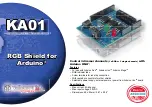
Pre-IRQ top of stack
x
PSR
PC
LR
R12
R3
R2
R1
R0
{aligner}
IRQ top of stack
Decreasing
memory
address
x
PSR
PC
LR
R12
R3
R2
R1
R0
S7
S6
S5
S4
S3
S2
S1
S0
S9
S8
FPSCR
S15
S14
S13
S12
S11
S10
{aligner}
IRQ top of stack
...
Exception frame with
floating-point storage
Exception frame without
floating-point storage
Pre-IRQ top of stack
...
Exception Model
71
SLAU356I – March 2015 – Revised June 2019
Copyright © 2015–2019, Texas Instruments Incorporated
Cortex-M4F Processor
NOTE:
Where stack space for floating-point state is not allocated, the stack frame is the same as
that of Armv7-M implementations without an FPU.
shows this stack frame also.
Figure 1-6. Exception Stack Frame
Immediately after stacking, the stack pointer indicates the lowest address in the stack frame.
The stack frame includes the return address, which is the address of the next instruction in the interrupted
program. This value is restored to the PC at exception return so that the interrupted program resumes.
In parallel with the stacking operation, the processor performs a vector fetch that reads the exception
handler start address from the vector table. When stacking is complete, the processor starts executing the
exception handler. At the same time, the processor writes an EXC_RETURN value to the LR, indicating
which stack pointer corresponds to the stack frame and what operation mode the processor was in before
the entry occurred.
If no higher-priority exception occurs during exception entry, the processor starts executing the exception
handler and automatically changes the status of the corresponding pending interrupt to active.
If another higher-priority exception occurs during exception entry, known as late arrival, the processor
starts executing the exception handler for this exception and does not change the pending status of the
earlier exception.
















































